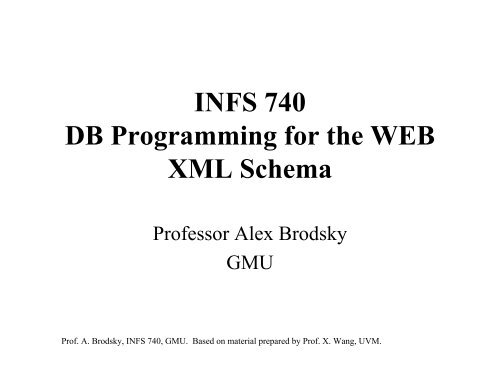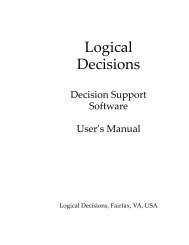INFS 740 DB Programming for the WEB XML Schema - Classweb
INFS 740 DB Programming for the WEB XML Schema - Classweb
INFS 740 DB Programming for the WEB XML Schema - Classweb
Create successful ePaper yourself
Turn your PDF publications into a flip-book with our unique Google optimized e-Paper software.
<strong>INFS</strong> <strong>740</strong><br />
<strong>DB</strong> <strong>Programming</strong> <strong>for</strong> <strong>the</strong> <strong>WEB</strong><br />
<strong>XML</strong> <strong>Schema</strong><br />
Professor Alex Brodsky<br />
GMU<br />
Prof. A. Brodsky, <strong>INFS</strong> <strong>740</strong>, GMU. Based on material prepared by Prof. X. Wang, UVM.
<strong>XML</strong> <strong>Schema</strong> PO Example po.xml<br />
<br />
<br />
<br />
Alice Smith<br />
123 Maple Street<br />
Mill Valley<br />
CA<br />
90952<br />
<br />
<br />
Robert Smith<br />
8 Oak Avenue<br />
Old Town<br />
PA<br />
95819<br />
<br />
Prof. A. Brodsky, <strong>INFS</strong> <strong>740</strong>, GMU. Based on material prepared by Prof. X. Wang, UVM.
po.xml Continued<br />
Hurry, my lawn is going wild!<br />
<br />
<br />
Lawnmower<br />
1<br />
148.95<br />
Confirm this is electric<br />
<br />
<br />
Baby Monitor<br />
1<br />
39.98<br />
1999-05-21<br />
<br />
<br />
<br />
Prof. A. Brodsky, <strong>INFS</strong> <strong>740</strong>, GMU. Based on material prepared by Prof. X. Wang, UVM.
Sequence Annotation<br />
The Purchase Order <strong>Schema</strong>, po.xsd<br />
<br />
<br />
<br />
Purchase order schema <strong>for</strong> Example.com.<br />
Copyright 2000 Example.com. All rights reserved.<br />
<br />
<br />
<br />
<br />
<br />
<br />
<br />
<br />
<br />
<br />
<br />
<br />
<br />
Attribute<br />
Prof. A. Brodsky, <strong>INFS</strong> <strong>740</strong>, GMU. Based on material prepared by Prof. X. Wang, UVM.<br />
Named Type<br />
Element<br />
Element
po.xsd Continued<br />
<br />
<br />
<br />
<br />
<br />
<br />
<br />
<br />
<br />
<br />
Prof. A. Brodsky, <strong>INFS</strong> <strong>740</strong>, GMU. Based on material prepared by Prof. X. Wang, UVM.
po.xsd Continued<br />
<br />
<br />
<br />
<br />
<br />
<br />
<br />
<br />
<br />
<br />
<br />
<br />
<br />
<br />
<br />
<br />
<br />
<br />
<br />
Anonymous Element<br />
Constraint<br />
Constraint<br />
Prof. A. Brodsky, <strong>INFS</strong> <strong>740</strong>, GMU. Based on material prepared by Prof. X. Wang, UVM.
po.xsd Continued<br />
<br />
<br />
<br />
<br />
<br />
<br />
<br />
<br />
<br />
<br />
constraint<br />
Prof. A. Brodsky, <strong>INFS</strong> <strong>740</strong>, GMU. Based on material prepared by Prof. X. Wang, UVM.
Main <strong>Schema</strong> Components<br />
Definitions of:<br />
• Complex types - sub-elements + attributes<br />
• Simple types - no sub-elements, constraints<br />
on strings (datatypes)<br />
Declarations of:<br />
• elements (of simple and complex types)<br />
• attributes (simple types), attribute groups<br />
Prof. A. Brodsky, <strong>INFS</strong> <strong>740</strong>, GMU. Based on material prepared by Prof. X. Wang, UVM.
Declaration vs Definition<br />
• declarations - things that will be used in an <strong>XML</strong><br />
instance document.<br />
– element declarations<br />
– attribute declarations<br />
• definitions - things that are just used in <strong>the</strong> schema<br />
document; a definition creates a new type<br />
– simple type definitions<br />
– complex type defintions<br />
– attribute group, model group definitions<br />
Prof. A. Brodsky, <strong>INFS</strong> <strong>740</strong>, GMU. Based on material prepared by Prof. X. Wang, UVM.
Constraints on Element Content<br />
Type of content<br />
– textOnly - only character data<br />
– elementOnly - only subelements<br />
– mixed - character data appears alongside subelements<br />
– any – anything goes<br />
– empty - no content (only attributes)<br />
<br />
<br />
<br />
<br />
<br />
<br />
<strong>XML</strong>: <br />
Prof. A. Brodsky, <strong>INFS</strong> <strong>740</strong>, GMU. Based on material prepared by Prof. X. Wang, UVM.
XSD Complex Types Indicators<br />
• Order Indicators:<br />
– all – appear in any order, but must all appear<br />
– sequence –all must appear, and in <strong>the</strong> given<br />
order (concatenation)<br />
– choice – may pick any one, but only one<br />
Prof. A. Brodsky, <strong>INFS</strong> <strong>740</strong>, GMU. Based on material prepared by Prof. X. Wang, UVM.
Examples<br />
<br />
<br />
<br />
<br />
<br />
<br />
Prof. A. Brodsky, <strong>INFS</strong> <strong>740</strong>, GMU. Based on material prepared by Prof. X. Wang, UVM.
• maxOccurs<br />
• minOccurs<br />
Occurrence Indicator<br />
Prof. A. Brodsky, <strong>INFS</strong> <strong>740</strong>, GMU. Based on material prepared by Prof. X. Wang, UVM.
Group Indicator<br />
<br />
<br />
<br />
<br />
<br />
<br />
<br />
<br />
<br />
<br />
<br />
<br />
<br />
<br />
<br />
Prof. A. Brodsky, <strong>INFS</strong> <strong>740</strong>, GMU. Based on material prepared by Prof. X. Wang, UVM.
Attribute Group<br />
<br />
<br />
<br />
<br />
<br />
<br />
<br />
<br />
<br />
<br />
Prof. A. Brodsky, <strong>INFS</strong> <strong>740</strong>, GMU. Based on material prepared by Prof. X. Wang, UVM.
Derived Types<br />
Subclassing of type definitions<br />
– derive by extension: extend <strong>the</strong> parent type with<br />
more elements<br />
– derive by restriction: constrain <strong>the</strong> parent type<br />
by constraining some of <strong>the</strong> elements to have a<br />
more restricted range of values, or a more<br />
restricted number of occurrences.<br />
– derive by reproduction - copy of <strong>the</strong> parent<br />
type<br />
Prof. A. Brodsky, <strong>INFS</strong> <strong>740</strong>, GMU. Based on material prepared by Prof. X. Wang, UVM.
Deriving Types by Extension<br />
- extend a base type’s content by adding<br />
elements and/or attributes<br />
<br />
<br />
<br />
<br />
Prof. A. Brodsky, <strong>INFS</strong> <strong>740</strong>, GMU. Based on material prepared by Prof. X. Wang, UVM.
Deriving Types by Restriction<br />
• Narrows <strong>the</strong> ranges or reduces alternatives of<br />
elements and/or attributes<br />
<br />
<br />
<br />
<br />
<br />
<br />
<br />
<br />
Prof. A. Brodsky, <strong>INFS</strong> <strong>740</strong>, GMU. Based on material prepared by Prof. X. Wang, UVM.
Preventing Type Derivations<br />
• There are mechanisms to prevent type<br />
derivations from a particular type<br />
definition<br />
Prof. A. Brodsky, <strong>INFS</strong> <strong>740</strong>, GMU. Based on material prepared by Prof. X. Wang, UVM.
Uniqueness<br />
<strong>XML</strong> <strong>Schema</strong>s can specify:<br />
• any attribute or element to be unique<br />
• combinations of attribute and element<br />
values to be unique<br />
• <strong>the</strong> range of <strong>the</strong> document over which<br />
something is unique<br />
Prof. A. Brodsky, <strong>INFS</strong> <strong>740</strong>, GMU. Based on material prepared by Prof. X. Wang, UVM.
Defining Uniqueness<br />
Need to specify<br />
• a selector which is an Xpath expression to a parent element<br />
• one or more fields - Xpath expressions to subelements or<br />
attributes within <strong>the</strong> selector<br />
unique vs key<br />
• Key: an element/attribute (or combination<br />
<strong>the</strong>reof) which is defined to be a key must<br />
– always be present (minOccurs must be greater<br />
than zero)<br />
– be non-nullable (i.e., nullable="false")<br />
– be unique<br />
• Key implies unique, but unique does not<br />
imply key<br />
Prof. A. Brodsky, <strong>INFS</strong> <strong>740</strong>, GMU. Based on material prepared by Prof. X. Wang, UVM.
Defining a Key<br />
Need to specify<br />
• a selector which is an Xpath expression to a parent element<br />
• fields - Xpath expressions to subelements or attributes<br />
















